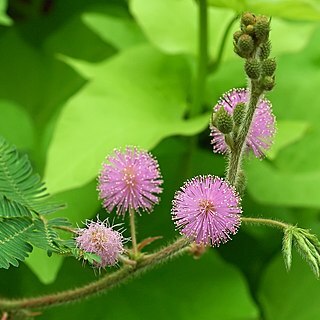Mostly herbs or shrubs, rarely trees, sometimes scrambling or climbing; prickles usually present. Leaves bipinnate, or the pinnae seeming almost digitate on account of the very short rhachis, rarely (not in our species) absent or modified to phyllodes; pinnae each with few to many pairs of leaflets. Inflorescences of ovoid or subglobose heads or (not in our species) spikes, which are axillary, solitary or more usually clustered and often ± aggregated. Flowers hermaphrodite or ♂, small, sessile. Calyx very small, irregularly laciniate or denticulate in our species. Corolla gamopetalous, 4-or sometimes 3-, 5-or 6-lobed. Stamens as many as or twice as many as the corolla-lobes, fertile. Anthers without any apical gland. Pods straight to circinate, flat, in our species ± bristly or prickly; at maturity the valves between the sutures splitting ± transversely into 1-seeded segments or rarely (not in our species) remaining entire; exocarp (at least in our species) not separating from the endocarp; sutures persistent.
Armed or unarmed perennial herbs, shrubs or small trees, often climbing or scandent, most species armed with prickles on the internodes. Stipules not spinescent, caducous. Leaves bipinnate, sensitive to the touch, rachis and pinnae without extrafloral nectaries, often with prickles on the rachis; leaflets opposite. Inflorescences consisting of pedunculate, axillary glomerules (in the introduced species), or spikes. Flowers tetramerous (in th s introduced species), uniform, bisexual. Calyx connate, valvate. Corolla connate, valvate. Stamens 4-8, free; anthers eglandular. Pods membranous to coriaceous, straight, at maturity falling apart in one-seeded segments, in the species naturalized in Malesia leaving the sutures as an empty frame. Seeds flattened, elliptic, with a hard testa, with areole, wingless, aril absent, endosperm absent; cotyledons large, radicle curved.
Shrubs or herbs, rarely trees or climbers, usually armed. Stipules not spinescent, usually 2 per pinna, small, caducous. Leaves bipinnate, often sensitive. Heads globose or spikes cylindric, solitary or fasciculate, axillary, pedunculate. Flowers small, bisexual or polygamous, sessile, usually 4-merous. Calyx connate, valvate, campanulate, toothed. Petals connate at base. Stamens 4 or 8, free, exserted; anthers without glands. Ovary many ovuled; style filiform. Legume oblong or linear, usually plano-compressed, membranous or leathery, composed of 1-seeded segments, separating from persistent margins. Seeds elliptic or orbicular, flat.
Fls perfect or the lower ones staminate; cal very small; cor gamopetalous, funnelform, 5-lobed; stamens mostly 10, with long, slender filaments; fr prickly, oblong to linear, obtusely tetragonal, the sutures (collectively forming a replum) about as wide as the persistent valves and separating from them at maturity; sprawling perennial herbs, armed with numerous stout hooked prickles; lvs bipinnate, sensitive, with small lfls; fls rose-purple, numerous in axillary peduncled heads. Nearly 600, New World. Description here based entirely on the small series Quadrivalves of section Batocaulon, forming the traditional genus Schrankia
Armed or unarmed, erect or scrambling shrubs or prostrate subshrubs (in Australia). Leaves bipinnate, lacking extrafloral nectaries, often with stipular thorns; pinnae few to many; leaflets opposite, sessile. Inflorescence capitate or spicate (in Australia) commonly arranged in pseudoracemes. Flowers 3-5-merous; sepals and petals connate. Stamens as many as or twice as many as corolla lobes, free; anthers lacking terminal gland. Pod membranous to coriaceous, dehiscing in 1-seeded segments; margins persistent. Seeds flat; pleurogram present.
Pods straight to circinate, flat, in our species ± bristly or prickly; at maturity the valves between the margins splitting ± transversely into 1-seeded segments or rarely (not in our species) remaining entire; exocarp (at least in our species) not separating from the endocarp; margins persistent.
Leaves 2-pinnate, or the pinnae seeming almost digitate on account of the very short rhachis, rarely (not in our species) absent or modified to phyllodes; pinnae each with few to many pairs of leaflets.
Inflorescences of ovoid or sub-globose heads or (not in our species) spikes, which are axillary, solitary or more usually clustered and often ± aggregated.
Mostly herbs or shrubs, rarely trees, sometimes scrambling or climbing, prickles usually present.
Calyx very small, irregularly laciniate or denticulate in our species.
Stamens as many as or twice as many as the corolla-lobes, fertile.
Corolla gamopetalous, 4-or sometimes 3-, 5-or 6-lobed.
Flowers hermaphrodite or male, small, sessile.
Anthers without any apical gland.

